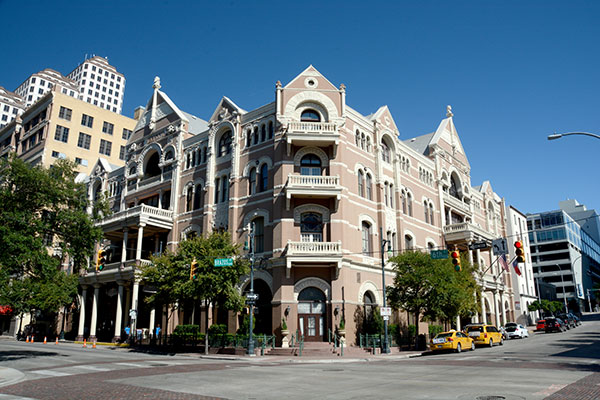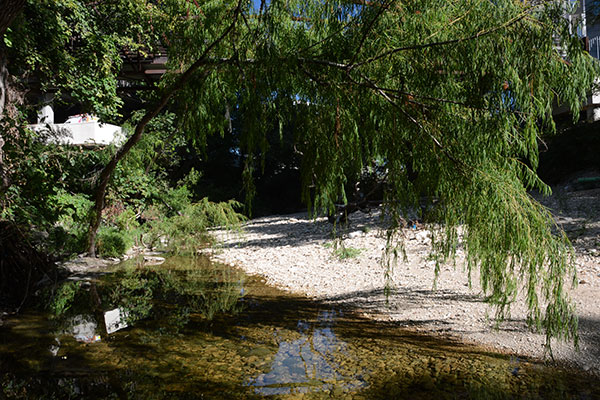Austin, population 978,908 (2019), the capital of Texas, is located 200 miles south of Dallas-Ft. Worth and 100 miles north of San Antonio. The City has had a TDR program for years aimed primarily at protecting groundwater recharge areas. For a description of the groundwater protection TDR program, please scroll down on this page to the section entitled Groundwater Protection. Immediately below is a profile of Austin’s separate Downtown program.

The Austin DTC program can be used to fund the preservation of historic structures like the Driskill Hotel shown here.

Downtown
For many years, Austin used a process called Central Urban REdevelopment, or CURE, to capture and redirect some of the windfalls from upzoning to community benefits; however, CURE did not formally specify the kind or amount of community benefit worthy of density bonus. This informal approach resulted, according to critics, in ad hoc deal-making between the City and developers. In 2008, the City adopted an interim density bonus program. Three years later, the 2011 Downtown Austin Plan called for replacing the interim program with a predictable system aimed at producing the most “at-risk” community benefits, including affordable housing, climate change measures, historic preservation, cultural vitality, pedestrian facilities and downtown open space.
The term “density bonus” often is used to describe mechanisms in which a project is allowed additional density when the development provides community benefits on site, an outcome that this web site does not consider to be TDR. And in fact, Austin’s current Downtown Density Bonus Program (25-2-586), (adopted in 2014) allows bonus density when developments include the following on site community benefits:
- (E)(1) Affordable housing
- (E)(2) Rainey Street historic preservation
- (E)(3) Daycare
- (E)(4) Cultural uses
- (E)(5) Live music
- (E)(6) On-site historic preservation
- (E)(8) Green building
- (E)(9) Publicly accessible on-site plaza
- (E)(11) Green roof
- (E)(12) Other (possibly off- as well as onsite).
This website takes the position that a TDR mechanism occurs when density bonus is awarded for off-site community benefits. Austin’s Downtown Density Bonus Program in fact allows bonus for three types of off-site community benefits. Importantly, these off-site benefits are achieved through payment of an in-lieu fee, which this website refers to as a Density Transfer Charge or DTC.
- (E)(1)(a)(iii) Affordable housing – Developers achieve bonus by paying a development bonus fee at a dollar amount per square foot amount set by ordinance and deposited in the Affordable Housing Trust Fund. According to a February 25, 2020 article, the DTC at that time varied from $3 to $10 per bonus square foot of floor area depending on the location of the receiving site. However, as of February 2020, consultants to the city recommended increasing the DTC on residential developments in the CC zone to $12 per square foot of bonus floor area and to institute a DTC between $12 and $18 per square foot for commercial developments which, as of February 2020, paid no DTC for affordable housing. The consultants based these recommendations on estimates of value increases created by bonus density and a goal of capturing 50 percent of that increment for public benefit (ECONorthwest 2020; Swiatecki 2020).
- (E)(7) Development Bonus Fee for Off-Site Historic Preservation – This code section grants bonus density when developers pay a dollar per square foot amount set by ordinance based on the district in which the receiving site is proposed. The fee is deposited in the Historic Preservation Fund.
- (E)(10) Off-site Open Space Development Bonus Fee – The project can achieve bonus density through payment of a development bonus fee for off-site open space at a dollar per square foot amount set by ordinance based on the district in which the proposed development is located. These fees are deposited in the Downtown Open Space Fund administered by the City.
As of February 2020, 54 downtown projects were reported to have paid a total of $8.3 million to the Affordable Housing Trust Fund in DTC in lieu of building some or all of the affordable housing otherwise required in order to achieve bonus residential density (Swiatecki 2020).
ECONorthwest. 2020. Austin Existing Density Bonus Program. Accessed 9-3-20 at http://www.austintexas.gov/edims/document.cfm?id=336208.
Swiatecki, Chad. 2020. City looks to hike fees on downtown developers opting out of affordability requirements. Austin Monitor. February 25, 2020. Accessed 9-3-20 at https://www.austinmonitor.com/stories/2020/02/city-looks-to-hike-fees-on-downtown-developers-opting-out-of-affordability-requirements/.
Groundwater Protection
The Water Quality section of Austin’s Land Development Code designates the most sensitive portions of watersheds as critical water quality zones, often including flood plains and other areas closest to streams and lakes. In all watersheds, development in critical water quality zones is limited to parks, golf courses, and open space or water-related uses, such as docks and marinas, in selected areas. Adjacent to the critical water quality zone, a water quality transition zone extends outward another 100, 200, or 300 feet depending on whether the waterway is considered minor, intermediate, or major. In a water quality transition zone, maximum impervious cover limits vary depending on the sensitivity of the watershed, ranging from 18 to 30 percent impervious cover. Land outside of critical water quality zones and transition zones are considered uplands. Again, depending on the sensitivity of the watershed, impervious cover limits can range from 30 percent to 65 percent and can increase as detailed below when coverage rights are transferred. Transfers are not allowed in the Barton Springs Zone but can occur in three other watershed categories: Suburban Watershed, Water Supply Suburban Watershed and Water Supply Rural Watershed.
In areas defined as Suburban Watersheds, 20,000 square feet of impervious cover can be transferred to an uplands zone for each acre of land in critical water quality zones that are dedicated to the city. Similarly, 20,000 square feet of impervious cover can be transferred for each acre left undeveloped in a water quality transition zone for each acre of land preserved in the buffer area for a critical environmental feature and for each acre of upland land used for wastewater irrigation and restricted against future development. Furthermore, 17,000 square feet of cover can be transferred per acre of land restored with native plants and used as a golf course or some other recreational facility and 10,000 square feet can be transferred for each acre of land in a water quality transitional zone used for wastewater disposal. The receiving tract must be within one mile of the transferring tract. Finally, the applicant must concurrently plat the transferring and receiving tracts and must transfer all development intensity at that time.
In another land category named Water Supply Suburban Watersheds, the impervious cover is more limited than in the Suburban Watershed category described above. The transferable coverage per acre of sending area land is lower than in the Suburban Watershed category. Likewise, the maximum cover achievable with TDR is lower: for single-family development, coverage can increase from 30 to 40 percent; and for commercial or multiple-family residential, cover can increase from 40 to 55 percent. However, the restrictions on transfer distance and concurrent platting or sending and receiving areas is similar to those found in the Suburban Watershed category.
In another category named Water Supply Rural Watersheds, the receiving areas in the Uplands Zones can go from one unit per two acres to one unit per acre for single-family residential uses that use TDR and from one unit per acre to two units per acre for clustered housing that uses TDR. For commercial or multiple-family residential development, TDR can be used to increase cover from 20 to 25 percent. The amount of development intensity that can be transferred is different from that allowed per acre preserved in the Suburban Watershed or the Water Supply Suburban Watershed categories.
Pat Murphy of the City of Austin reported in April 2005 that these transfer provisions had been used many times but that the City had not attempted a formal inventory of the land preserved as a result. He also mentioned that preservation occurred on a case-by-case basis in the Barton Springs Zone even though the formal transfer mechanism does not apply in that zone.
